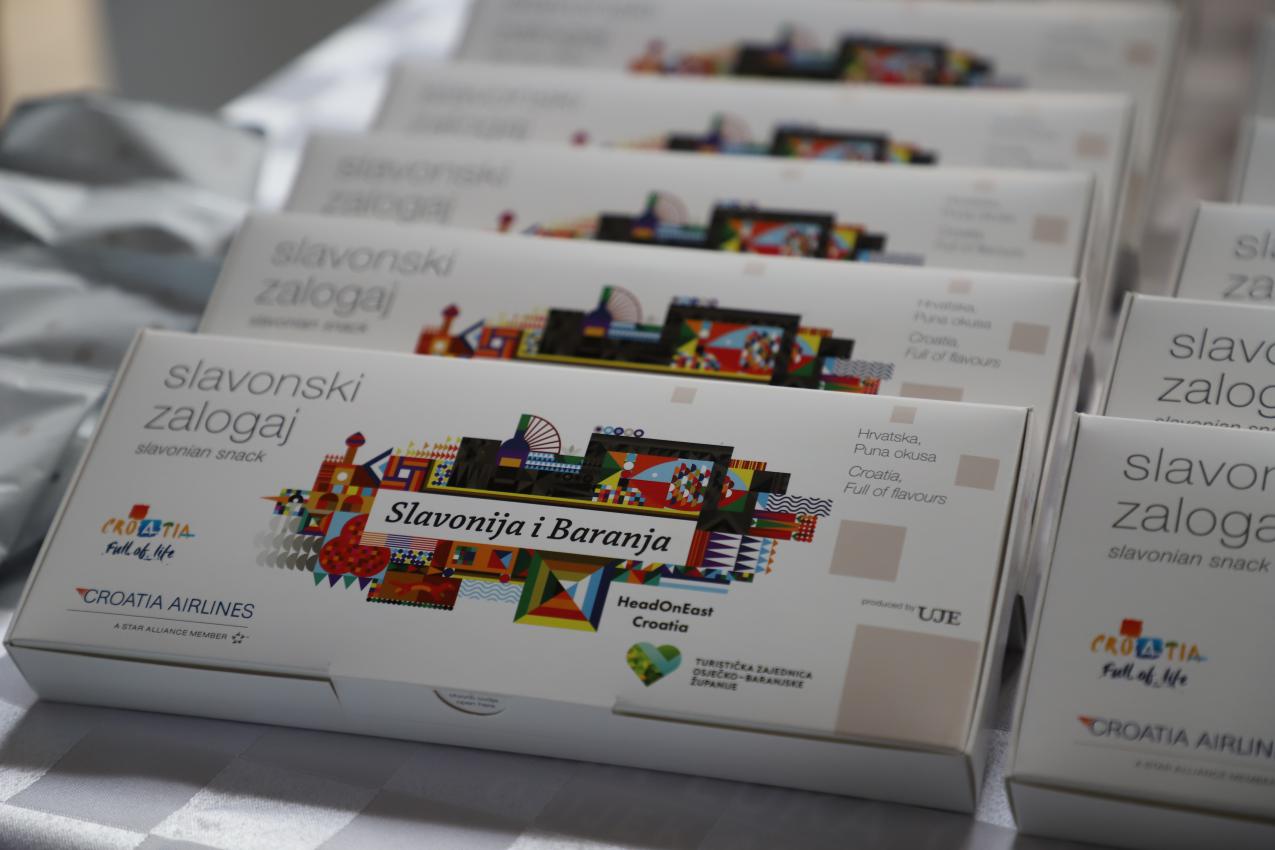Vinkovci Business Incubator Exceeds All Expectations
September 2, 2022 - Since its opening two and a half years ago, in February 2020, the Vinkovci Business Incubator has met, and, it is safe to say, exceeded all expectations and predictions - all capacities have been completely full for a long time, and only in the past year 22 companies with 63 employees were located in that area, while more than 160 entrepreneurs participated in organised workshops and round tables with the aim of increasing their entrepreneurial knowledge and skills.
As Glas Slavonije writes, wanting to be informed about their business plans and to get first-hand information and hear suggestions on how to further improve their relationship with the Business Incubator, Mayor Ivan Bosančić visited the tenants and on that occasion pointed out that the Business Incubator was one of the first major projects of his team, to which he especially proud.
"I am proud of my team that we managed to implement such a demanding project, worth HRK 21 million, with a minimal correction of only five percent, which means that in the end we obtained grants in the amount of HRK 20 million. The most important of all is the fact that today the Business Incubator is completely filled with tenants from different business spheres, from the IT sector, design, production to hospitality. Most of them have increasing needs and are constantly looking for additional workers", said Mayor Bosančić.
All of them, he said, have the support of the City in their efforts to improve and advance their businesses, especially when it comes to new projects and new employment.
As a reminder, the Vinkovci Business Incubator has an area of 1,861 square meters, consisting of 5 production and 13 office business spaces, an administrative part of the building, a conference hall of 100 square meters and a multi-purpose hall with the possibility of partitions, also with a total area of 100 square meters, as well as a co-working space and a canteen. In addition to space, the Business Incubator also provides tenants with business equipment and provides support through business consulting, education, connections, presentations, promotion and visibility in the initial and most critical stages of the development of their companies. All these tools are key to increasing the number of companies that survive on the market and encouraging their growth and development, as well as creating new jobs.
For more, make sure to check out our dedicated Business section.
Less and Less Slavonian Employees Working on Croatian Coast
September the 1st, 2022 - There are less and less Slavonian employees working along the Croatian coast, particularly in Dalmatia where they were once commonplace in bars, restaurants and in hotels.
As Morski writes, the number of Slavonian employees who work seasonally along the Croatian coast has dropped significantly. For years, Slavonian employees were a kind of "sign" of every summer tourist season along the Adriatic, but that seems to have come to an end.
The statistics of the Osijek Regional Office of the Croatian Employment Service (HZZ), which was the (second) largest pool of seasonal workers for the Adriatic, show that there has been a significant drop in the number of seasonal workers from Eastern Croatia.
During the first seven months of this year, around 1,100 people from Osijek-Baranja County were employed in various seasonal jobs along the coast. Compared to the same period back in 2019, there's been a decrease, as 1,823 people were employed in those jobs back then. The figures were even lower over the past two summer seasons, but these were the unprecedented pandemic-dominated years, which cannot be compared to anything else.
Ankica Vuckovic, head of the Labour Market Department of the Osijek branch of the Croatian Employment Office, concluded that there is less interest in Slavonian employees heading to work at various Adriatic hotels because there is an increasing need for employers in Osijek-Baranja County itself, meaning that much more stable job offers are now available to the unemployed in their own home county through year-round employment.
The strengthening of Croatia's continental tourism is one of the main reasons why there are fewer Slavonian employees now working on the Adriatic coast, but it isn't the only one. Well known Croatian economic analyst Damir Novotny believes that there are three aspects of this reduction. First of all, the costs during the height of the summer season are very high; if an employer doesn't provide workers with accommodation, seasonal employees simply cannot survive.
People from Slavonia aren't ready to live in containers or similar accommodation units, which their employers along the coast intend for them to stay in. Second of all, the wages on the coast are lower than what they can earn in, say, Austria, Germany, and Switzerland, which has opened up to Croatian workers and absorbed a lot of labour from here. Higher-quality staff, who speak the languages of those countries, could very easily get a good job in the aforementioned Central European countries, especially in the ''boom'' after the pandemic. There's a great demand for catering, hospitality and tourist services in these countries, so the labour force from Slavonia is mobilised more towards these countries than towards Dalmatia,'' explained Novotny.
He added that the domestic component should not be neglected either, i.e. the increase in the number of small OPGs and family tourist accommodation capacities, which is visible in the entire Danube region, from Baranja to Ilok, as reported by Vecernji list journalist Suzana Lepan-Stefancic/N1.
For more, make sure to check out our dedicated business section.
:BRUT - Baranja Rural Trail Cycling Event in Slavonija and Baranja
August 30, 2022 - At the junction of Slavonia and Srijem, through vineyards and hills, forests and plains, through museums and monuments, where the Danube kisses the sky, on September 3, a new BRUTAL bicycle race is coming. After a successful race in Beli Manastir, in Baranja, BRUT arrives in Vukovar. It is a 25 or 50 km race through vineyards, fields, forests, and unpaved roads.
In addition to the race itself, on September 1 and 2, we can expect a bicycle tour of the Bata-Borovo industrial heritage as well as street art murals as part of the VukovArt program, a tourist tour around Vukovar, a children's race and a traffic safety workshop, and of course, evening entertainment programs on the 2nd and on the 3rd day of the event.
The full program, as presented on the official website of :BRUT, will look like this:
September 1, 2022 :BRUT Murali starting at 16:00 - 18:00 tour of the city of Vukovar and murals on buildings by bike.
September 2, 2022 :BRUT
Small children's races starting at 10:00 and duration until 12:00, city center Vukovar.
Preschool kids, 100m races.
Traffic safety - joint action with the Ministry of Interior and PD Vukovar.
September 2, 2022 :BRUT Sights starting at 16:00 a tour of the sights in the city of Vukovar – a tourist tour by bike and then a gathering in the bar "Vukovarsko naj".
September3, 2022 :BRUT Vukovar

:BRUT official race map
Start of the race on September 3, 2022 at 16:00h (registration of participants from 14:00h)
Start - zone target: Salaš Goldschmidt (on the road between Vukovar and Sotin)
Length 25 km and 50 km (choice of route on the trail)
The path is circular in shape. Cyclists ride 1 lap in the 25km race and 2 laps in the 50km race.
The time limit (time-cut) is 3:00h (until 19:00h), and everyone who does not complete one lap in 80 minutes will not be able to go to another and will be counted time for :BRUT Vukovar 25.
After the race, lunch and drinks are provided for all participants and :BRUT Chill with a DJ, fun and socializing.
For an awesome weekend of walking, cycling, and enjoying the sights and events, we encourage you to apply here (participation includes the start package, meal and drink, and guaranteed entertainment).
For more, make sure to check out our dedicated Lifestyle section.
Croatia Airlines Serves Slavonian Snack to Promote Destination
August 30, 2022 - 600,000 passengers on many routes, from Zagreb to destinations around the world, will see and taste the Slavonian snack.
As SiB writes, the Osijek-Baranja County Tourist Board, Croatian Tourist Board, and Croatia Airlines are from August 1 to November 30, 2022, implementing the joint promotional project "Tastes of Slavonia". Passengers on all flights of the Croatian national airline are served a Slavonian meal, which represents a special experience, and at the same time promotes Osijek-Baranja County as a tourist destination, as well as the gastronomy of Slavonia, Baranja, and Srijem. This way, more than 600,000 passengers on 10,000 flights to 30 international and domestic destinations can taste Slavonian delicacies, and thus destinations.
On this occasion, yesterday (August 29, 2022), a press conference was held at Osijek Airport, where the director of Osijek Airport Ivan Kos, director of the Osijek-Baranja County Tourist Board Ivana Jurić, director of commercial affairs of Croatia Airlines Slaven Žabo, Osijek Deputy Mayor Dragan Vulin, and Osijek-Baranja County Prefect Ivan Anušić spoke about the project "Tastes of Slavonia".
The Director of Osijek Airport, Ivan Kos, initially thanked Croatia Airlines for the partnership on the "Tastes of Slavonia" project and expressed his belief that Slavonia and Baranja will be presented to passengers on all lines through this unique project.
"The products of Slavonia and Baranja in the air through the Tastes of Slavonia project in cooperation with the Croatian Tourist Board and Croatia Airlines will last four months. It is a project that invites you to visit the destination through the flavours, because good food is one of the first associations with Slavonia and Baranja, with Osijek-Baranja County as the largest tourist county in the east of Croatia. This confirms once again that the east means hedonism, which means a lot of good food and drink, as well as the events that the destination offers. We are happy that we are promoting the destination not only on domestic but also on international flights, and we continue our good cooperation with Osijek Airport, Osijek-Baranja County, the City of Osijek and the Croatian Tourist Board," said the director of Osijek-Baranja County Tourist Board Ivana Jurić.
She explained that "Slavonian snack" is part of the "Croatia full of flavour" platform as a project of the Croatian Tourist Board, and that the package distributed to passengers includes crackers based on corn and red pepper, which are associated with Baranja, its fish stew, and other flavours that we find in dried meat products, followed by čvarak spread, kulen (spicy sausage), pickled vegetables and a contemporary interpretation of the Slavonian Šapice as a dessert. There are different package sizes, from the crackers handed out on shorter domestic flights to the full package given to passengers on longer international flights.
Osijek-Baranja County
The Director of Commercial Affairs of Croatia Airlines, Slaven Žabo, pointed out that through this joint project, which is based on the wider project of the Croatian Tourist Board (Croatia, Full of Flavours), a range of products/meals for flights was put together that actually represent traditional Slavonian specialties, spices, and other products of this region.
"This joint project is the crown of cooperation between Croatia Airlines, the Tourist Board of Osijek-Baranja County, the City of Osijek, the Croatian Tourist Board, and Osijek Airport, through which we established an international Osijek-Munich route that operates all year round. Its added value, apart from enriching Croatia Airlines’ offer on its flights, is that we have also created the preconditions for the promotion of the specialties of this region," said Slaven Žabo.
The Deputy Mayor of Osijek, Dragan Vulin, expressed his satisfaction that, as he said, the best possible flavors will be available to all passengers on Croatia Airlines flights and will thus contribute to the branding of the food from this area. He pointed out that compared to last year, the City of Osijek now records 55 percent more arrivals and 28 percent more overnight stays of tourists, and in August (until August 25) the record from August last year was exceeded.
"Through the project "Slavonian snack" we can see the continuation of the activities for the promotion of Slavonia and Baranja that we announced and started several years ago. We are still doing this together with Croatia Airlines, our Tourist Board, the Croatian Tourist Board, and the City of Osijek. We are glad that around 600,000 passengers on many routes, from Zagreb to destinations around the world, will see and taste the Slavonian snack, and it is precisely our goal to increase the visibility and quality of our service and offer", said Prefect Ivan Anušić. He added that the results of tourist visits in Osijek-Baranja County this year are better than the record year of 2019 and that the County wants to remain the leader in the development of continental tourism in Croatia, so it continues to strengthen tourism and the economy in all segments.
For more, make sure to check out our dedicated Lifestyle section.
Eventful September in Baranja - Over 15,000 Visitors Expected
August 24, 2022 - The Biggest Croatian Fish Stew Day, Fishing Days, Wine Marathon, and World Fishing Championship. September in Baranja looks eventful. Over 15,000 visitors are expected.
As Glas Slavonije writes, since the beginning of the year, more than 13,000 tourists visited Baranja, accounting for approximately 23,000 overnight stays.
The results are significantly better than last year, reaching the level of the record 2019. A real tidal wave of arrivals and overnight stays is expected during September when several events will be held in Baranja that have recently become famous outside of the county borders.
“Judging by the announcements, we expect about 15,000 visitors at the September events alone, mostly domestic, but with a respectable number of foreign visitors as well”, said Matej Perkušić, director of the Baranja Tourist Board, stressing that this should be felt in the occupancy of accommodation capacities throughout Baranja, but also in Osijek and its surroundings. It all starts with the Biggest Croatian Fish Stew Festival, which will take place in Beli Manastir on September 3. It is a "two in one" competition - the Croatian Championship, for the winners of the Slavonia-Baranja competition, and the amateur championship, for everyone else. In total, more than 200 chefs are expected.
“About 70 amateur chefs have applied so far, and we expect the majority of applications a day or two before the deadline, which is in less than a week”, said Perkušić. Along with several interesting games, the bands TS Žeteoci and Magazin will be in charge of entertainment.
The middle of September is reserved for another established Baranja event, Fishing Days in Kopačevo. Ten thousand visitors were there last year, and as many are expected this year as well.
“Last year, because of the pandemic, we decided that Fishing Days would be a three-day event, and it turned out to be a complete success. Therefore, this year they will be held on Friday, Saturday, and Sunday (September 16 - 18)”, said Željko Cickaj, mayor of Bilje Municipality, pointing out that visitors can expect between four and five tons of fish, to which the "gastro programs" must be added, organised alongside with the central part. In addition to local delicacies, guests will also be able to enjoy a cultural and entertainment program. On Friday, after the official opening, the band Gazde will play, followed by TS Kvinta in the tent. Saturday is reserved for The Garden, klapa Rišpet, and TS Nesanica (in the tent), and on Sunday there will be a traditional fish stew cook-off, several traditional music, and dance ensembles, and TS Sitan Vez will perform.
“Although this year there is a problem with acquiring the needed quantities, the members of the hunting club from Kopačevo started their preparations on time, so there will be enough fish” Cickaj pointed out.
And on the last weekend of September (Friday and Saturday), all roads will lead to Zmajevac, to its mountain paths and wine cellars.
“We expect that approximately 2,500 marathoners will “run” the marathon this year, possibly more. Applications started back in February. For example, the team from Hungary that participated in the marathon last year had six members. This year, they expanded the team to 73 members, for both days” on behalf of the organizer, the Surduk Association, said Kristijan Horvat. This year, the partner countries will be Hungary and North Macedonia. An interesting entertainment program awaits visitors. Although the dice are still “coming together”, Frajle, Hungarian violinist Nyari Bernardett, and Macedonian artist Tijana Dabčević will perform together on Friday. The arrival of Tamara Tadevska, who defended the Macedonian colours at the Eurovision Song Contest, is also planned. Concerts on two stages are planned for Saturday.
How good is your knowledge of eastern Croatia? Take the CROMADS test above - how many places do you recognise?
For more, make sure to check out our dedicated Travel section.
Osijek Software City - Best Place on the Planet for Family Life
August 24, 2022 - Nathan arrived in Osijek from Arizona via Colorado and Prague. Not only did he find a job there, but also what he calls the ideal place for family life. The Osijek Software City movement is slowly, but surely coming to life.
As RTL writes, Osijek is a city where IT companies produce good software. Where do you acquire the necessary knowledge and skills for that? Where are the educated and motivated workers employed in quality and promising companies? This is how the objectives of the Osijek Software City project were presented, were they achieved?
Ten years from the first vision of Osijek as a regional IT center, and seven years until the first company in the IT park. The story of Osijek Software City unfolded slowly.
“It went slowly and it was difficult, but now it's going faster and faster”, Denis, one of the initiators of this story, told RTL. Better cooperation with universities will create the necessary IT specialists and scholarship programs with the City and the County that will attract young people.
“For us, this current pool of young people is no longer enough to turn Osijek into a true center of the IT industry, and we will really need to attract and import a lot of foreign students”, says Denis Sušac, director of the IT company.
Nathan arrived in Osijek from Arizona via Colorado and Prague. Not only did he find a job there, but also what he calls the ideal place for family life.
“Osijek could be one of the best cities on the planet for family life”, said Nathan Chappell, a developer.
The family spirit is present in the workplace, and his family is also helping him learn the Croatian language.
Ivana, on the other hand, studied languages, but after finishing her studies, she felt that it was not her life's calling.
“And then, little by little, I started poking around in IT to see what was there and what I was really interested in and I came across this testing”, said Ivana Belak, software tester.
She didn't want to leave Croatia and rather wanted to find the job she desired here, and that, she says, came true.
“We think that today young people can live very well working in Osijek, without leaving, and this trend of going to Ireland, Sweden, Germany is slowly coming to a halt”, claims Sušac.
The number of IT people in Osijek is growing. The goal of recognising Osijek as a city where IT experts live and work is becoming closer, and without their skills life is almost unimaginable today.
For more, make sure to check out our dedicated Lifestyle section.
Discover the Croatian Danube: Fishing Village of Aljmaš (part 2)
August 21, 2022 – In TCN’s new series, Discover the Croatian Danube, we explore the little villages that lie on the banks of this mighty river. We started from the point where the river Drava “surrounds its water and name to the Danube”, in a small fishing village called Aljmaš. If anything, you might know that Aljmaš is a Marian shrine with a big modern church and that it’s somewhere in Slavonia (could be Baranja?). There is a lot more to these few streets that make the village. A very long and rich history in a geographically important and interesting position. Legends, traditions, and stories of hardship, friendship, and mischief. Learn about the former in Aljmaš part one and buckle up for the latter in the following paragraphs.
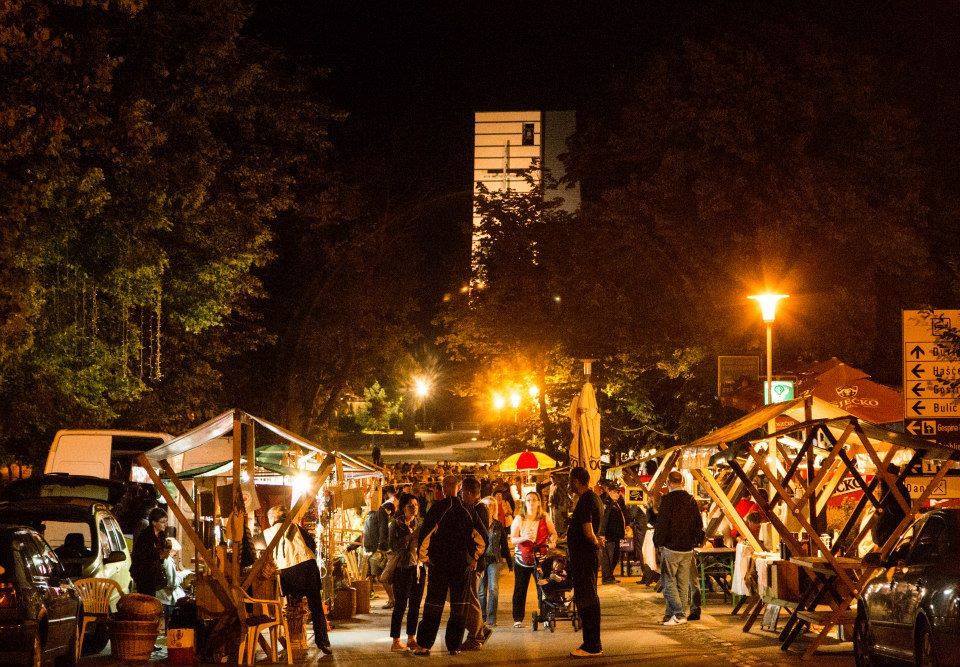
Photo: Aljmaška ribarska noć
Every village has its traditions. They are usually tied to the big holidays or otherwise important events, serve to bring people together, and are overseen by village Google. If you don’t know about the phenomenon, just ask any local grandmother about current events. In Aljmaš, its geography was used to make sure that things run smoothly. Before the modernisation of the infrastructure which took place in the 2000s, there were three canals for the rainwater to drain into the Danube. The embankments were used for social purposes where boys would gather and hang out on one, girls would do the same on another, and the third, you guessed it, was reserved for the smooth running of surveillance.
Other events couldn’t do without it, either. One of them was something called lelujle. In the spring, on Palm Sunday, there was a tradition for the ladies to let their romantic interests know who they were. This was, of course, done using old pots and pans which the girls would throw over the gates of their hopefully future husbands. This all gave the security something to do, as they would have to be the ones to either prevent the accumulation of unwanted old pottery or clear it out afterward. Usually with the words “better take this rubbish back to your mother’s house”.
The final quirky tradition presented here, and the author’s favourite is called buše. It occurs as the accompanying content, or the entertainment to go with the hard work that is the winter preparation of pig meat traditional for Slavonia. To lighten the mood, it was the task of a volunteer trickster to manage mischief. The primary goal was to play a trick on the host and acquire as much meat and snacks as possible, all while making sure that your identity remained completely hidden. Among other things, wine barrels were used to that end. The loot would then be served at a party.
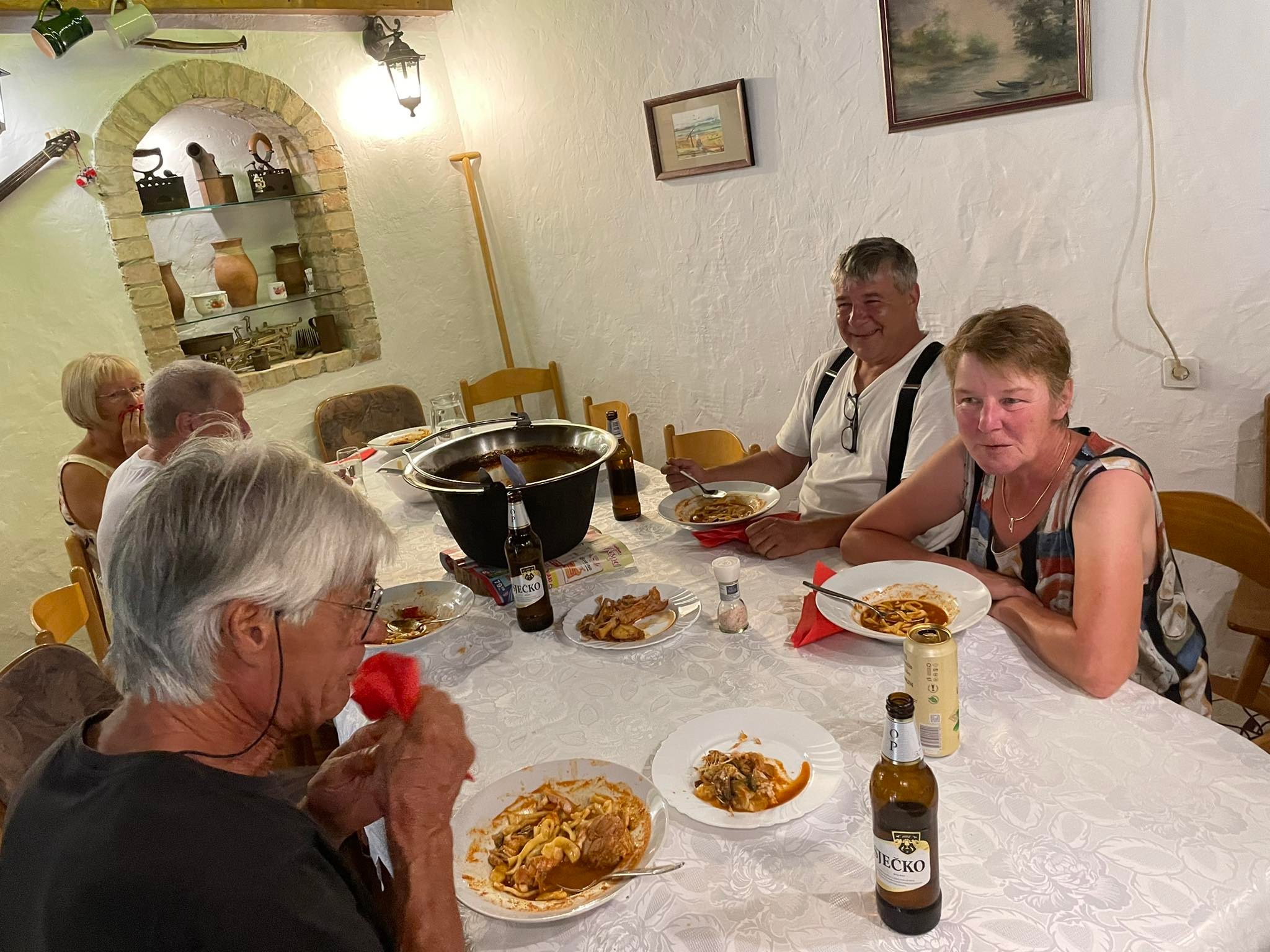
German fishing crew enjoying a delicious dinner
The Danube is the heart of Aljmaš. Fishing, camping, and picnics on the riverbanks are a way of life. Naturally, one of the most important local dishes is fish stew. This delicious, hearty meal is usually made with carp, catfish, pike, or a combination of those, over an open fire in a hanging pot, with an addition of smoked sweet and spicy paprika, onions, and wine. The ingredients can vary, and every good cook will keep their secret, but one thing is sure – love is always the primary spice. And Aljmaš breathes love for the river, for food, for good company, and a good time. A true testament to this is the annual Aljmaš Fishing Night. It was born spontaneously out of a night of good fun, cooking and a friendly cook-off between Dalmatian cooks with fish from the Adriatic Sea and local cooks with Danube fish. The eighth Aljmaš Fishing Night held in 2019 hosted over 8000 visitors who all cooked, ate, sang, and danced all night long. Unfortunately, due to the pandemic, the festival was put on temporary hold, but the organisers cannot wait to be back and have already started planning Fishing Night 2023. A little fishy told us it might be the biggest and best one yet. It is usually held in late May or early June. For more info, to get a feel of the atmosphere, and to make sure you don’t miss the next one, follow Aljmaška ribarska noć on Facebook.

Photo: Susi Petrijevčanin
The driving force of the events, traditions, and all other ways in which Aljmaš lives, is of course its residents. There might not be many, but they are the most generous and friendly bunch. Not only will they greet you with a smile, but they will also host you, show you around and feed you. One of them is Susi Petrijevčanin, a German nurse who decided to move to Aljmaš for love, the fresh air, and the perfect lifestyle. In her words, it’s a place where you can let your child go outside to play all day. They might come back muddy, tired, knees scraped, but they’ll always be happy and healthy. To ensure that a lunch of delicious fish stew is followed by lovely desserts, Susi has opened her dessert shop in Aljmaš, which you can follow here.
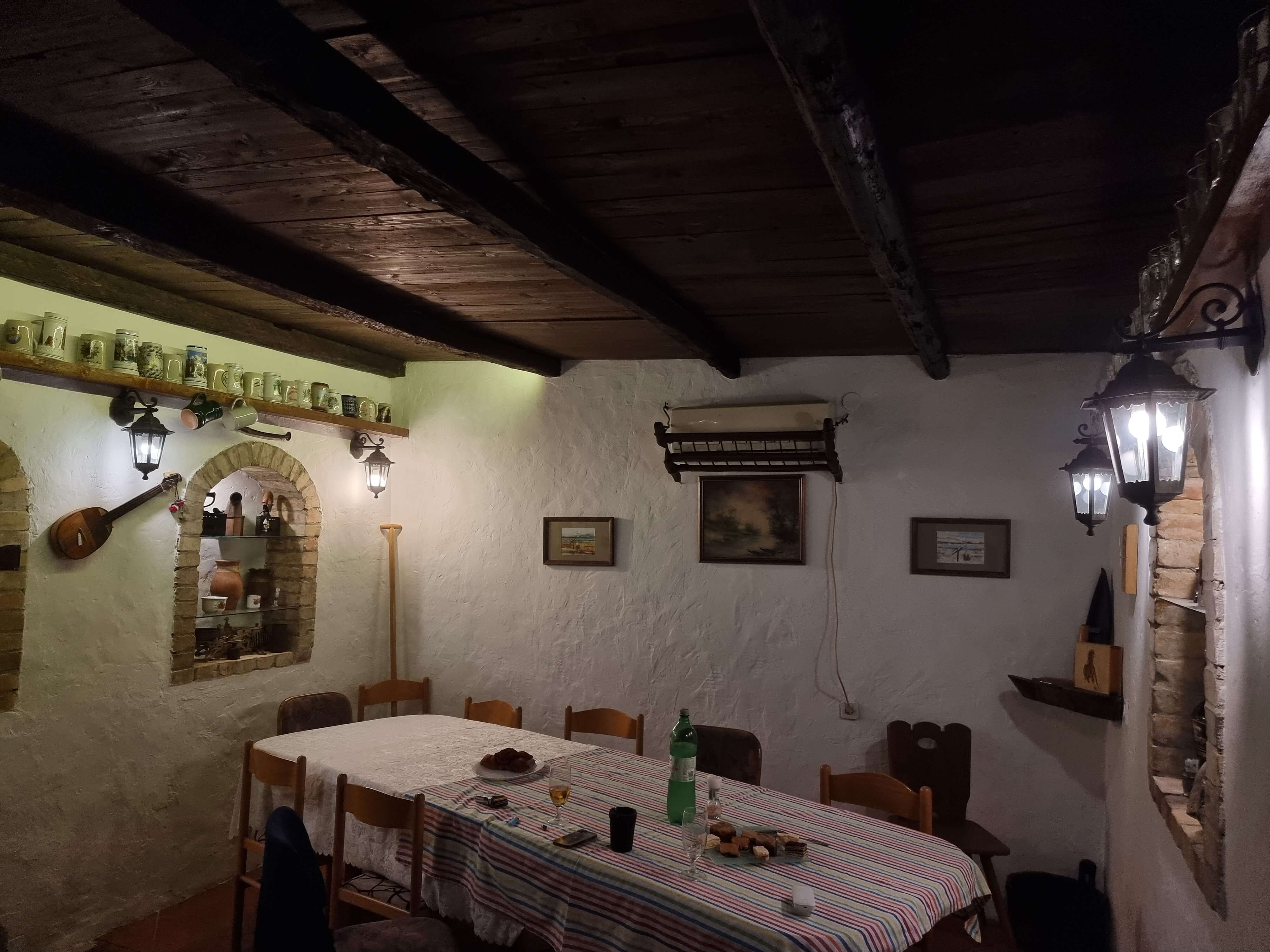
If any of this inspires you to visit Aljmaš, we encourage you to do it yesterday! Our guide Marina will be more than happy to help and will ensure that you have the best time. She will tell you a story or two about the village, her family who has lived in Aljmaš for five generations and might be traced back to Napoleon Bonaparte, as well as what the best ways are to catch and prepare fresh Danube fish. If she likes you, she might even show you her house which has stood in the village since before the 1900s. Whether it’s the original bricks, wooden structure, or the wine in the cellar, there is an incredibly special feel to the place.
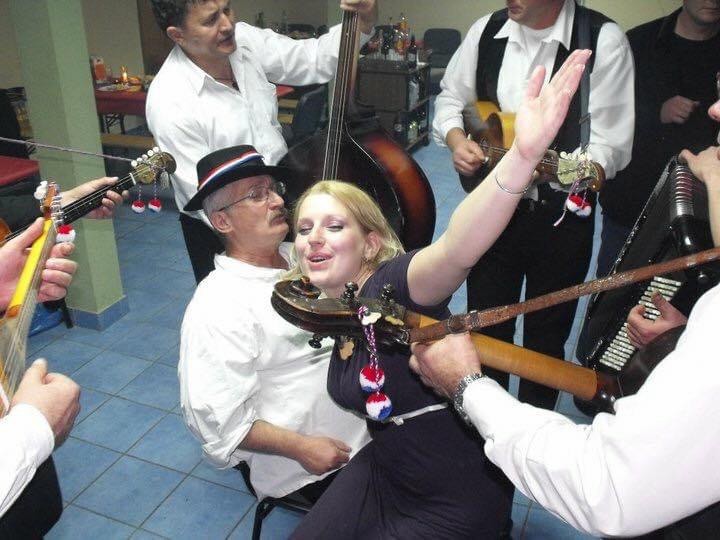
Marina with her father in traditional wear. Standard atmosphere in the village.
If you would like to contact Marina and plan your visit, email TCN This email address is being protected from spambots. You need JavaScript enabled to view it., Subject Aljmas.
How good is your knowledge of eastern Croatia? Take the CROMADS test above - how many places do you recognise?
For more, make sure to check out our dedicated Travel section.
Darija Walter of PLANTaža on Art Project Urban Intervention Osijek
August 17, 2022 - A wonderful artistic intervention has just dawned in the city of Osijek. It put the spotlight on the historical beauty of cities. A tram stop that dates to 1926 was refurbished by the famous street artist Lonac, under the Urban Intervention project headed by Darija Walter.
Darija is a woman changing things at the local level, to stimulate change on a global level. In recent years, life in Croatia has focused more and more on the capital, while the rest remains neglected, uninhabited, and without events and plans. Darija operates through the association PLANTaža. She also works on a series of projects that truly change Osijek, and not only Osijek but contribute to the entire community. Journal spoke with Daria about all the current and upcoming plans that, little by little, bring life to where it should have always been.
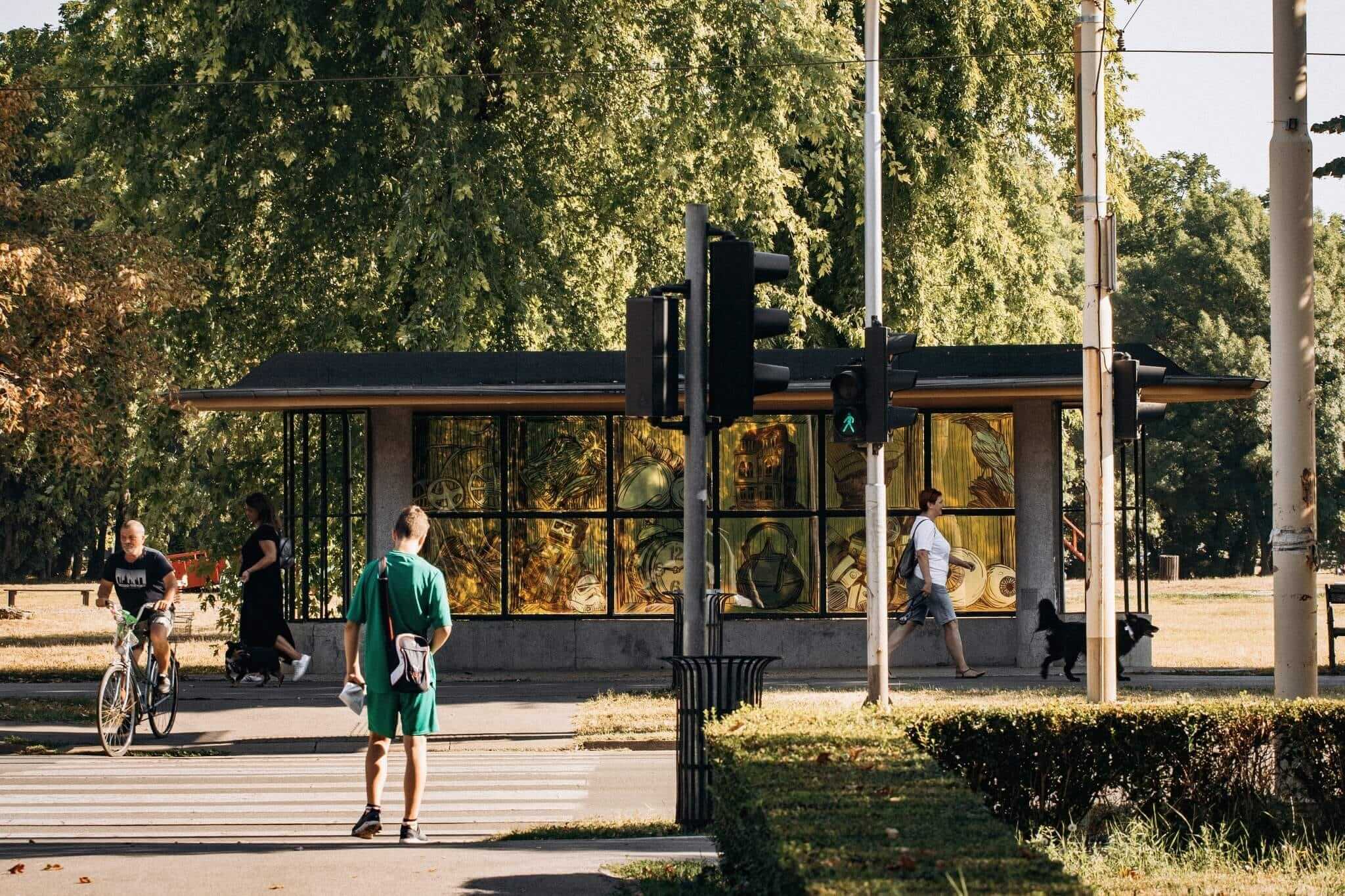
Darija Walter on her beginnings, art…
You have now been in the PLANTaža association for eight years, how do you see those years, compared to the time before you became part of it, how much has it changed your life?
I have been working with the PLANTaža Association since the very beginning of the association's work when an enthusiastic group of people gathered who wanted to start some new stories in Osijek. Today, eight years later, I realize how much the association has influenced my life. It gave me a new opportunity that I was not aware of before and thus determined my path. I have always known that I wanted to do work that has a direct impact on solving problems in the community, offers sustainable and meaningful solutions, and involves all age groups. It never crossed my mind that I would do that in the city I love so much. The city I wanted to leave eight years ago because I didn't see any prospects.
"It would be nice to write about Slavonia in an optimistic tone"
How much, in your opinion, does investment and contribution to a city, especially not the capital of Croatia, mean, on a larger level, while most investments are oriented specifically towards Zagreb or the south of the country?
Like any other area, the city of Osijek could use investment, especially in the field of creating new jobs. Although we do not stand side by side with the big companies, the association is an employer that, through EU funds, offers the opportunity for employment and first work experiences. We are not the only ones there. We cooperate with a whole range of associations that operate in Osijek and continue to develop their stories despite numerous obstacles. Croatia does not only consist of Zagreb. It is precisely for this reason that equal investment should be encouraged so that other parts of the country can also expect development.
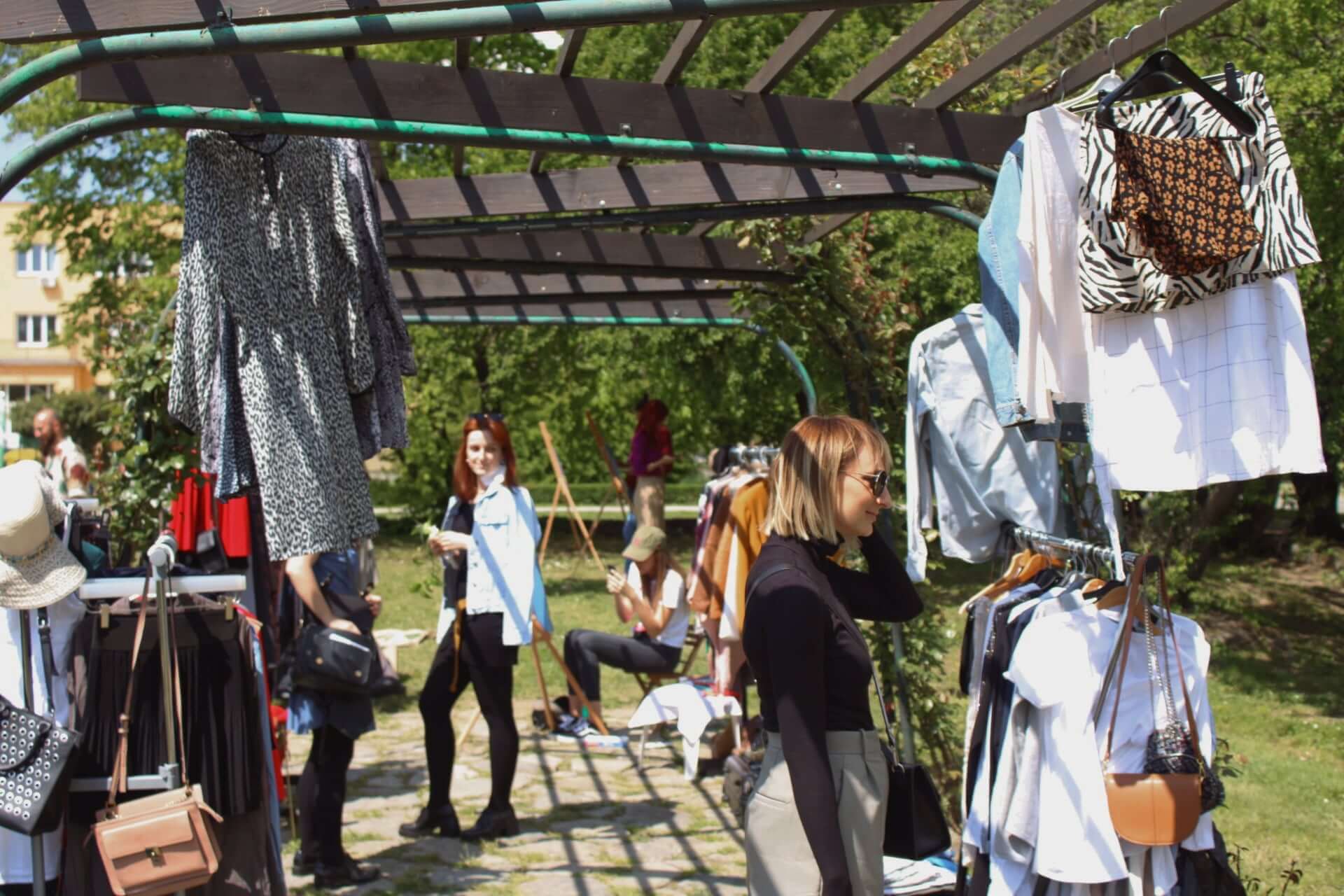
In addition, it would be nice if Slavonia and Baranja were written about in an optimistic tone, and not just about mass emigration. Although unfortunately many have sought their happiness outside this region, life has not disappeared. Changes are happening, people are trying, and a lot is happening regardless of all the challenges that stand in the way of success in this ungrateful environment of ours.
"Only through our involvement can we influence changes"
What is your motivation for projects? This is now your lifestyle, not just an occupation.
Working in an association becomes a way of life, whether I want to admit it or not. Classic working hours do not exist. Vacations have become an invisible concept to me because most of the activities are carried out during the summer. My office is wherever I can connect to the Internet. My motivation is to influence change, however small it may be. Only this way can we contribute to the creation of some new, sustainable and healthy habits that can only further enrich our lives. Only through our engagement can we directly affect changes in our community – which in the long term affects the understanding of the kind of society we leave to our descendants as an inheritance.
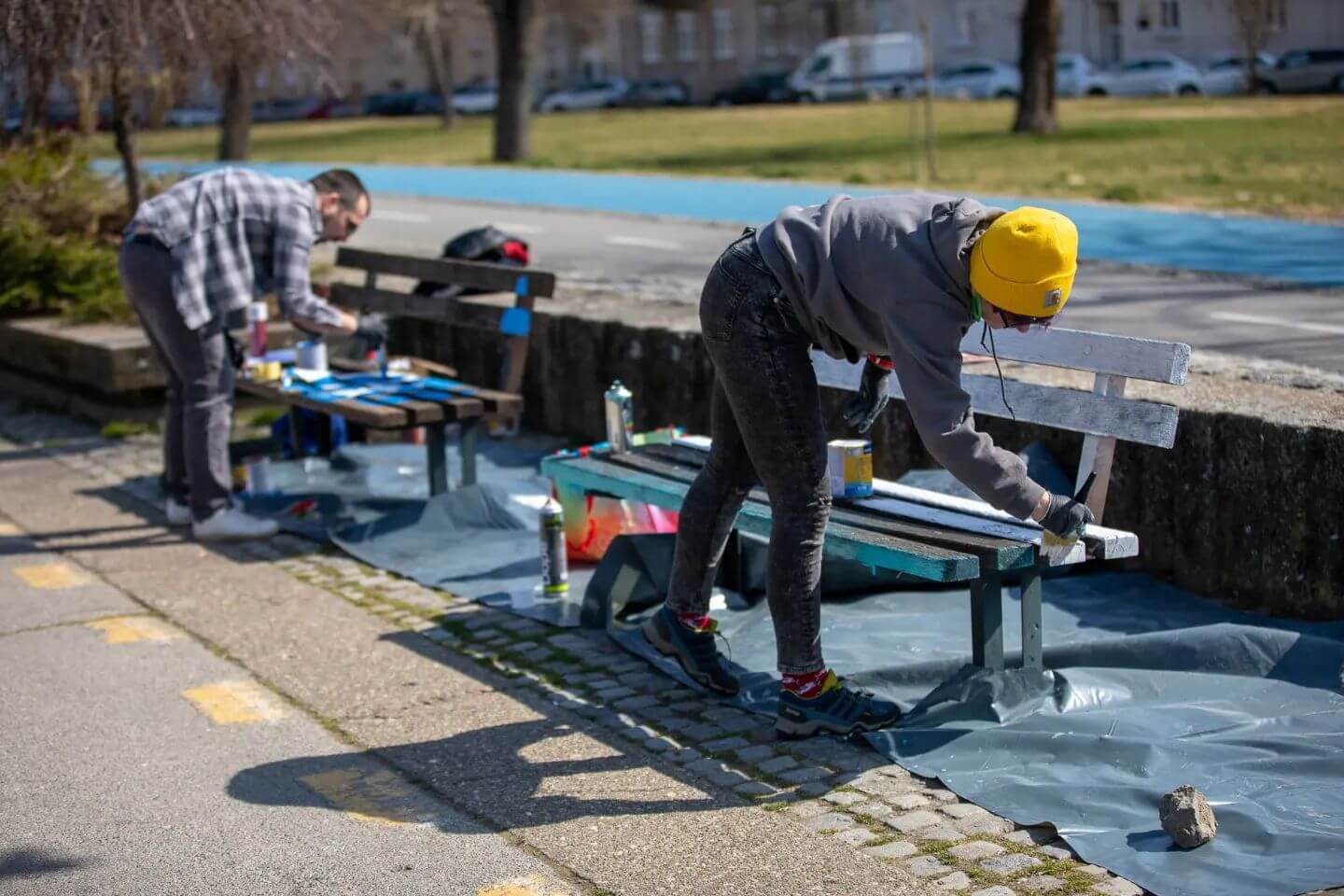
Reconstruction of the oldest tram stop
You have just presented an art installation within the oldest tram stop in Osijek through the Urban Intervention project, can you tell us more about it?
The Urban Intervention project is being implemented for the fourth year in a row to present artistic illustrations within the oldest tram stop in Osijek, which dates back to 1926. The station was neglected for many years and left to wait for better days. This is exactly why, with the support of donors and the Conservation Department in Osijek, we decided to restore the glass surface and give it a new purpose.
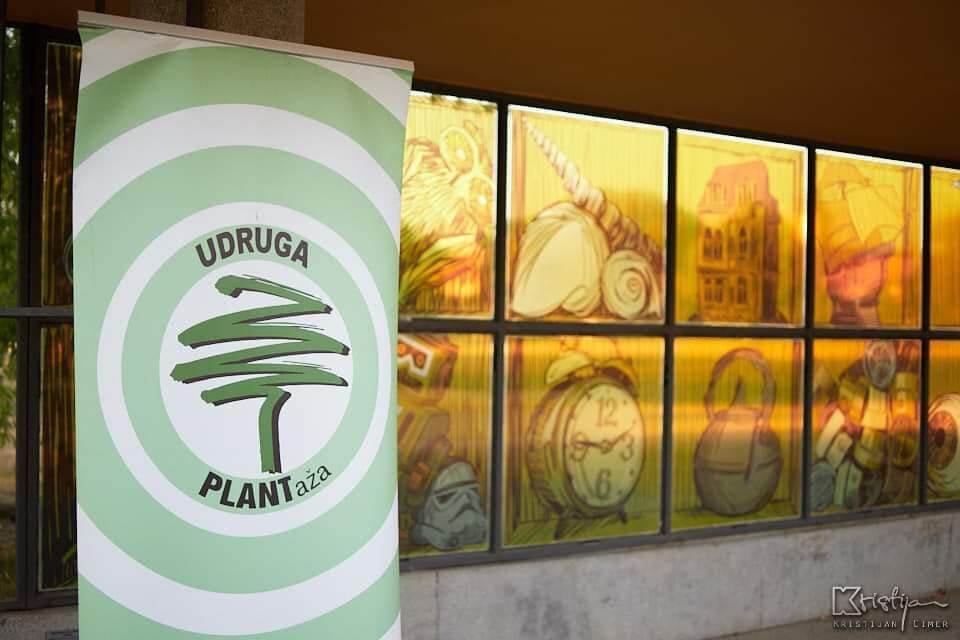
We desire to return the stop to its original state, refurbish the entire surface, and with the support of the City, restorers, and the Conservation Department in Osijek, make it a real small gallery space, unique in Croatia. Until that happens, we will continue to present new artistic illustrations to further promote urban culture and new artistic practices. This year we presented an artistic illustration signed by the famous Croatian street artist Lonac. So far, Slađana Zubić, Tea Jurišić, and Vedran Klemens have introduced themselves to the Osijek audience.
Project Urbani Osijek
The Urbani Osijek project connects urban culture through the tourist offer of the city. How much did it contribute to the tourist image of Osijek?
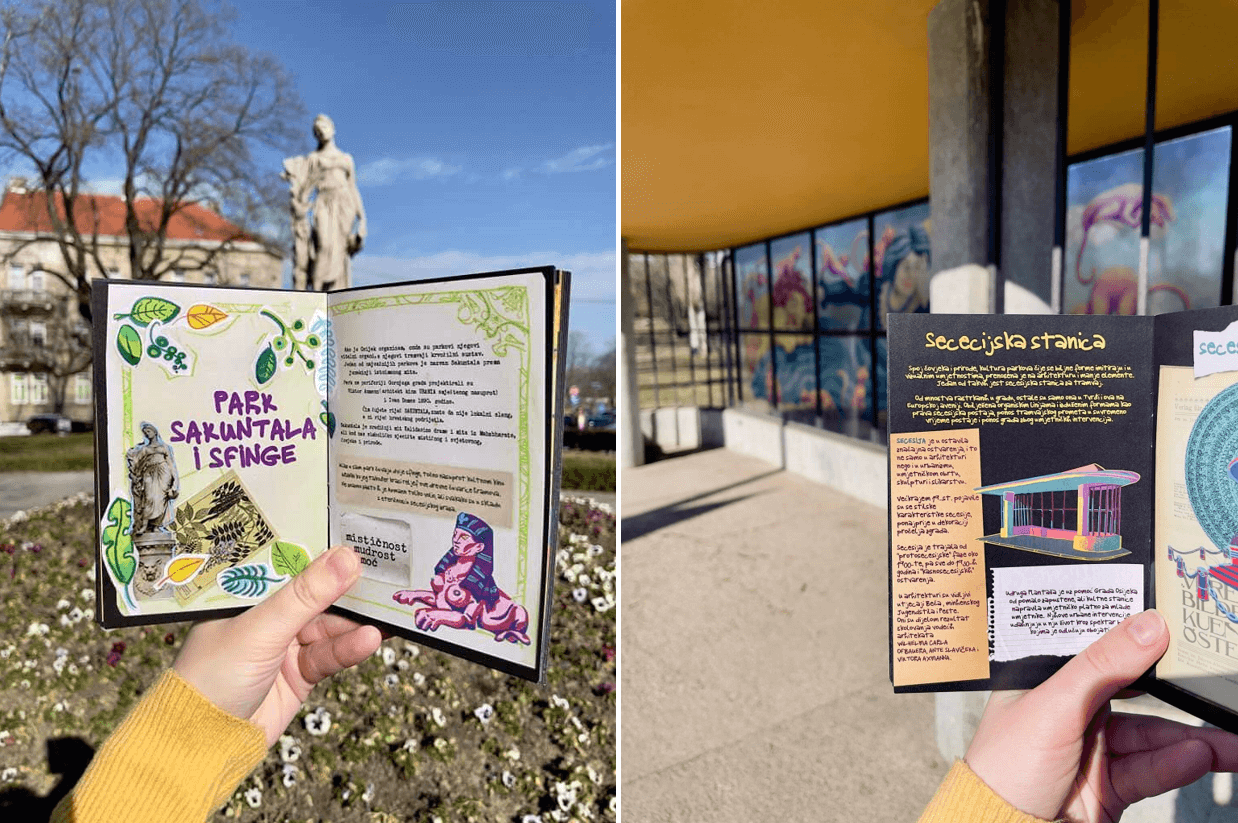
The Urbani Osijek project was created last year by the secretary of the association, Vedran Grizbaher. The project itself includes the promotion of urban culture through a touristic approach and contains a whole series of creative activities such as cycle-urban routes, concept lectures I Travel Solo in which female travelers are presented. There is also an urban guide to Osijek, which was created as a desire to present the contents of Osijek in one place in an illustrated version beautifully painted by Yellow Yuri. The project gave birth to creative solutions and original tourist products, such as the already mentioned urban guide, which we plan to promote even further.
The first art workshop
You are preparing the first art workshop "Vibration of Art" soon, whose theme will be Nikola Tesla. Can you tell us more about that?
The Vibration of Art is a project whose activities we are very much looking forward to. Our first activity will start soon at the Slama Land Art Festival, which has been organized by the Slama association for more than 15 years. This year the theme is Nikola Tesla. In accordance with that, we will hold a land art workshop and a Tesla transformer workshop under the expert guidance of Nikola Faller. The project itself also includes informal theater dance workshops led by Mira Sekereš from Shine Dance Studio, panel discussions, and poetry evenings.
What is she looking forward to?
Do you spend the whole summer working and what are you looking forward to in the autumn?
This year is unique for several reasons, so the whole summer has been busy for me. I will take a short break in September, and until then I will continue in the same rhythm. In the autumn, I will be working on the PLANTida ecologically sustainable festival and a whole series of new things that have yet to come. In any case, I'm happy with this busy creativity, I enjoy the process of learning and tinkering, and as long as it's like that, it doesn't need to be any other way!
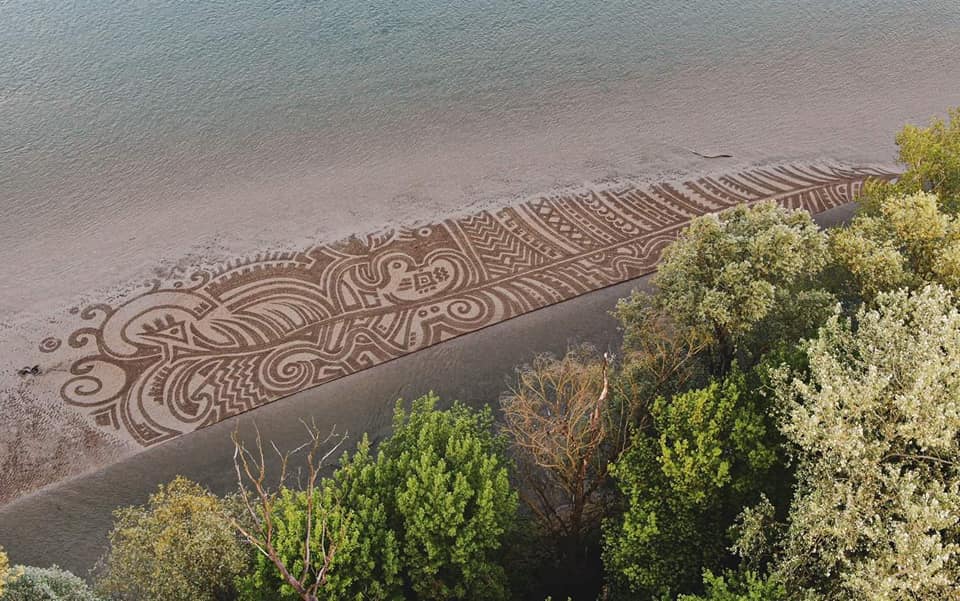
All photos by Udruga PLANTaža
Osijek is the regional centre of Slavonia and Baranja, and much like the rest of eastern Croatia, it is indeed full of life. Why aren't you here?
How good is your knowledge of eastern Croatia anyway? Take the CROMADS test above - how many places do you recognise?
For more, make sure to check out our dedicated Lifestyle section.
Brace Yourselves in Slavonia: Winter is Coming and Zimnica is Now
August 18, 2022 – Picture this. You live in Slavonia. You are 16, it is the height of summer, plans include swimming in the Danube all day and partying all night. Guess again. There’s more important business. It involves plums, apricots, tomatoes, peppers, maybe beetroots. And it’s not a very weird salad. You are now old enough to make your own zimnica.
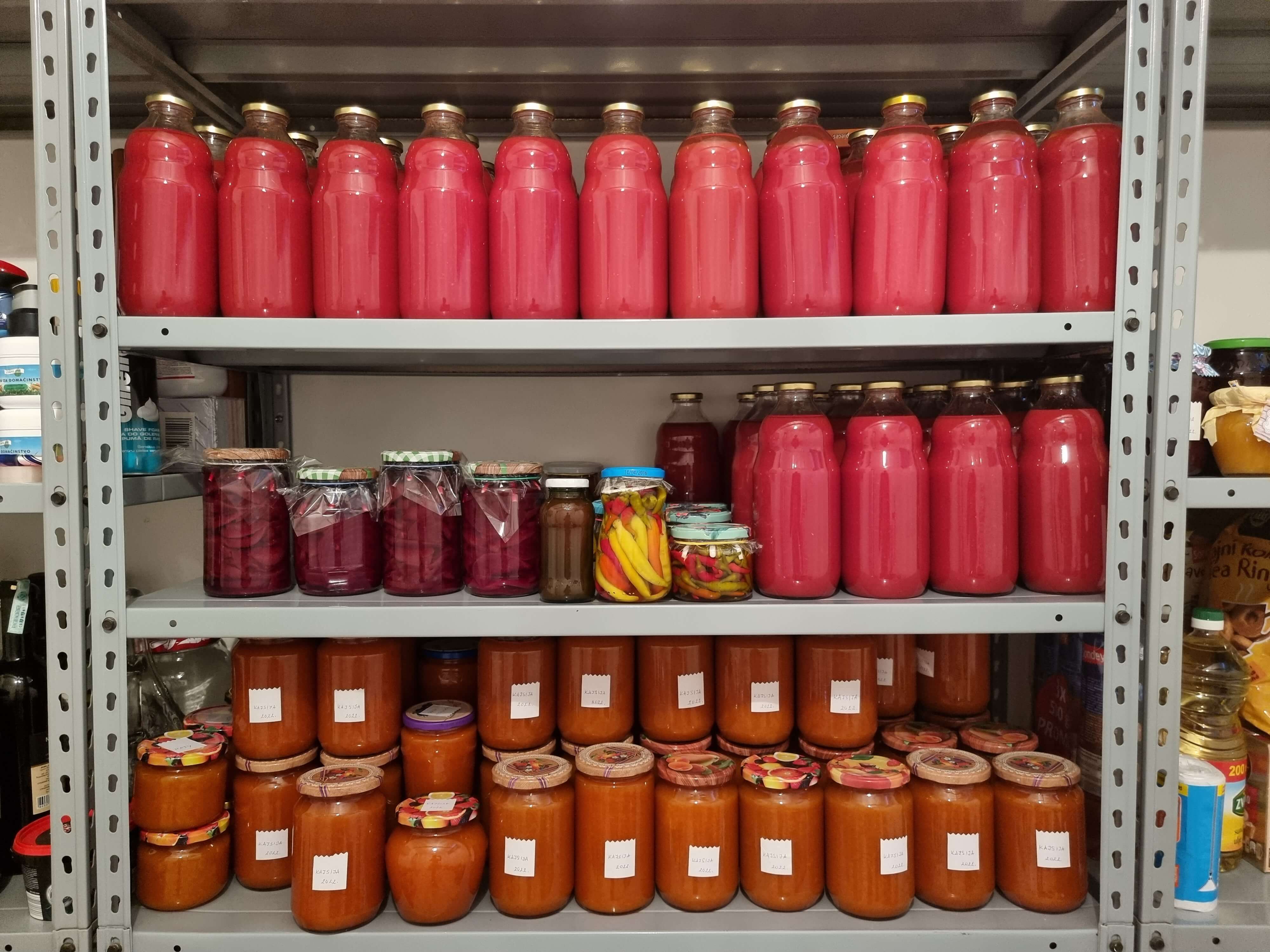
The winter staples - tomato passata, apricot and plum jam, pickled beetroots and peppers
While not a uniquely Slavonian event, zimnica, which is the Croatian word for anything that is kept specifically for the winter, plays an extremely important role in eastern Croatia. Preparing jars, bags, and dishes of fruits and vegetables for the winter is almost a form of art. Though things are different nowadays, winter in Slavonia used to be awfully long, cold, and dark, food was hard to come by, and it was of utmost importance to ensure that you preserved as much as you can. These days life is not as hard, and you can buy anything at any time, but the tradition does live on. Homegrown and homemade is always just so much better.
The preparations take place all summer long, as the fruits ripen, using various techniques. The most popular ones include pickling, jamming, and passing.
Pretty much any vegetable can be pickled using vinegar, salt, sugar, and water. The hierarchy of pickled vegetables is as follows:
1) Turšija is a mix of bell peppers, cauliflower, carrots, onions, and cucumbers, all pickled together in a plastic barrel. It takes top tier and gets served almost daily with all kinds of stews, meats, and even sandwiches, the adventure is in you.
1) Cabbage takes the same tier as turšija because it’s used to make a dish called sarma, which is the number one winter dish. It is almost mandatory to develop a love-hate relationship with it based on how often it’s made in Slavonian households.
2) Beetroots taste slightly sweeter, very red, never eaten while wearing white. Never frowned upon.
3) Solo whole bell peppers – neutral good, few hate them, few love them. Eaten if served, rarely an object of fear of missing out.
4) Other – like solo pickles, usually fetched when you run out of the good stuff.
5) Green tomatoes – now, that’s simply weird.

Just like any vegetable can be pickled, any fruit can be made into jam or rakija. Rare are jobs that are as annoying as picking up plums, apricots, peaches, pears, or apples from the ground and separating them into three buckets: good for jam, good for rakija, and good for nothing. The latter is usually completely rotten fruit, which is the most fun to pick up, and that bucket is taken to the back to be composted. The rakija bucket is dumped into a big barrel where the fruit is left to ferment, later distilled, and poured into the nicest bottles to be served on every occasion. Finally, the good fruit is eaten or used in cakes, but more importantly, jammed. There are a few different recipes for jam, depending on the fruit. The ubiquitous plum is treated as the queen and can be found in cakes, tašci, knedle, crepes, and on the breakfast table daily. Try the simple trick of cooking a large clay dish full of pitted plums with some sugar in the oven for a few hours and thank us later.
Now, you might wonder why one would go out and buy 250 kilograms of tomatoes on a Wednesday morning. Because that is market day, and the tomatoes went for a good price. And the ones from your garden were part of one too many salads. One of the most important ingredients of Slavonian cuisine is tomato sauce. Sunday lunch is unimaginable without a good broth, followed by the meat that was cooked in it served with some of the red velvety goodness. Tomato soup cures colds, cases of flu, and an array of other illnesses. It also makes for an incredibly easy and delicious dinner.
The process of preparing passata for the winter has a few steps. First, invite friends and family to help. This is a group job. Second, make sure that you’ve got some tools like a tomato press with a questionable origin, which you might or might not remember buying some 25 years ago. Even better if it’s your mother’s. Third, have some coffee. Fourth and final, work for 12 hours straight washing your tomatoes, cutting them, boiling, pressing, boiling again, bottling, and tucking for a cozy rest of 36-48 hours. Now you can rest easy knowing that you can store your 60 litres per household, getting through another long frosty winter in Slavonia.

Step no. 4
Traditional jam and tomato sauce are used in restaurants all over Slavonia and Baranja, where you can also try some of the dishes mentioned in the article, like tašci, sarma, and tomato soup. And that is just scratching the surface. Why aren’t you here?
How good is your knowledge of eastern Croatia anyway? Take the CROMADS test above - how many places do you recognise?
For more, make sure to check out our dedicated Lifestyle section.
Bikademy App Emphasises Potential for Cyclo Tourism in Slavonia
August 3, 2022 - Bikademy – an academy where a good, strong connection is mandatory. The only other requirement is a bicycle. This innovative app explores cyclo tourism and places Croatia on the map of big European cyclo tourist destinations.
Bikademy is a unique Croatian product intended for all those who like cycling to explore new destinations and their cultural and natural heritage. It promotes cities and regions as desirable cyclo tourism destination, rewarding cyclists for their efforts. A bicycle is an ideal means of exploration, being slow enough to take in your surroundings, and fast enough to cover longer distances.
The Bikademy application is completely free for users who, just like in other academies, are called Bikademy Students. Within the application, you can choose from different Bikademy Studies, each representing a particular region, county, or city. Within each Study, there are different Exams, that is, locations and places of cultural or natural significance.
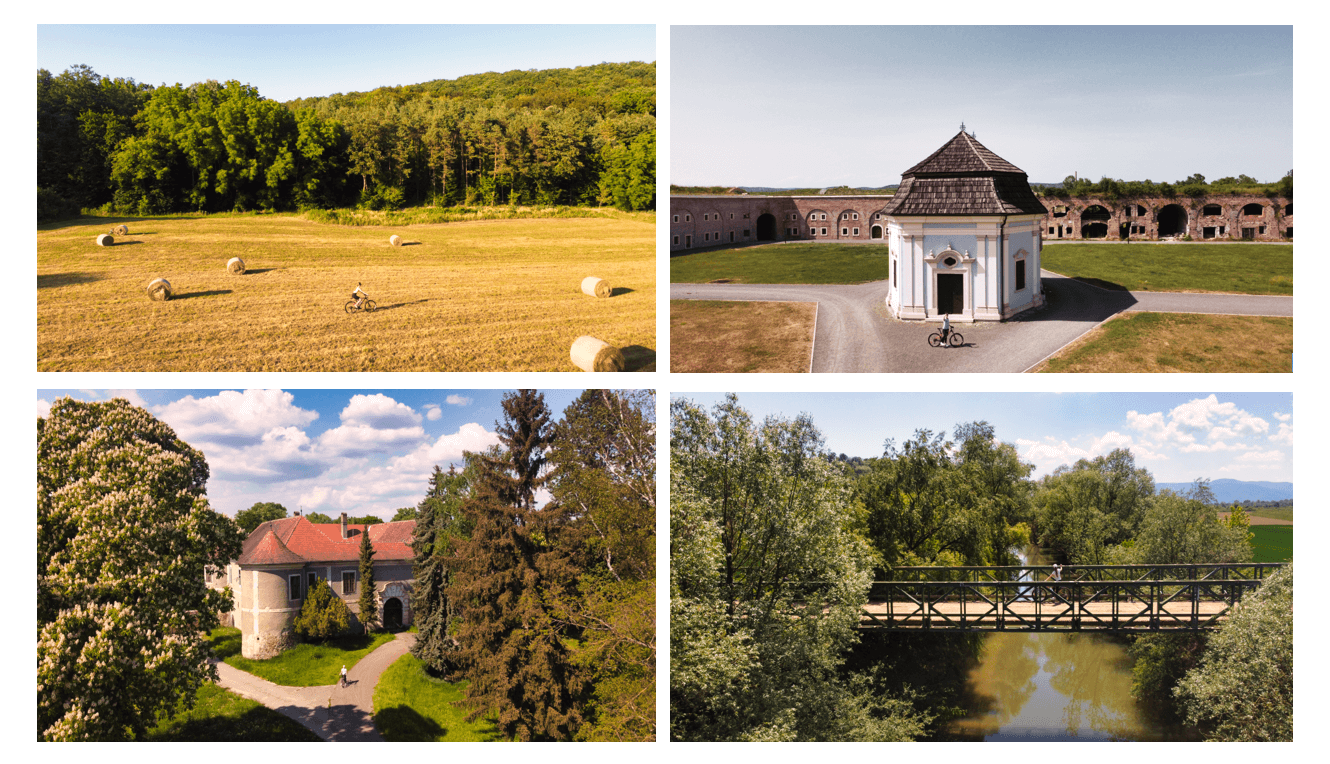
Photo: Bikademy
The main task of a Bikademy Student is to cycle to each Exam in the chosen Study. It is required to take a selfie and check in via the application. After passing all the Exams of the chosen Study, Bikademy Students receive a prize from the Bikademy sponsor, GIANT Croatia.
In just four steps, you too can pass the Bikademy Exam (photos attached).
1 Install the application and register
2 Cycle to the Exam (location)
3 Check in through the application
4 Repeat the previous two steps

Photo: Bikademy
One of the first Bikademy Studies was the Brod-Posavina County with seven Exams: Vrpolje, Gajna, Tvrđava Brod, Petnja, Stara Kapela, Cernik and Tvrđava Stara Gradiška.
Check out the highlights of the Brod-Posavina Study here.
This Study is intended for more experienced cyclists who want to cover longer distances. The Exams are of similar difficulty for the four other four Slavonian counties. They reveal that Slavonia is not only made up of fields and valleys but also rich cultural heritage, natural resources, superb gastronomy and hospitality, at every turn. Although everyone knows about Slavonia, it is yet to be discovered as a hidden tourist gem perfect for cycling.
In cities like Zagreb, Šibenik, and Berlin, there are less demanding Studies for every traveler who wants to explore the area by bike.
Through its social networks, Bikademy presents its cyclo tourism destinations, and examples from practice, but also continuously rewards its followers. They are preparing new surprises and opportunities soon, so make sure you follow them on social networks.
If you would love to see Bikademy in your area, feel free to contact them, as they are expanding beyond the borders of the Republic of Croatia.
As for your holidays, choose your destination and explore it by bike, get to know the culture and nature of the region, and win prizes. Cycle your exams!
To learn more about some of the people behind the movement, check out TCN's interview with Krešimir Herceg.
For more on lifestyle in Croatia, explore our lifestyle section.


